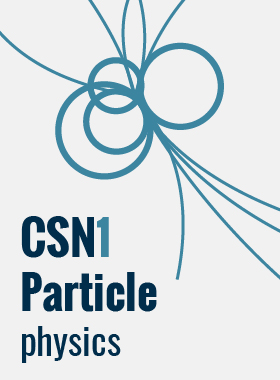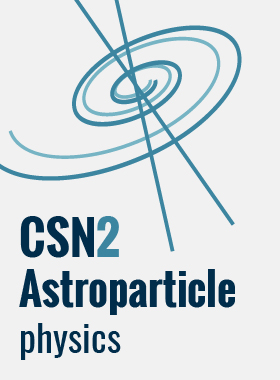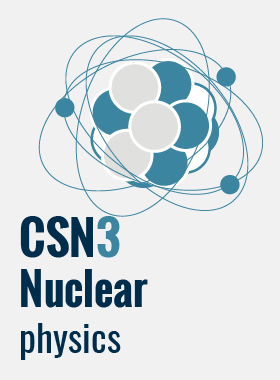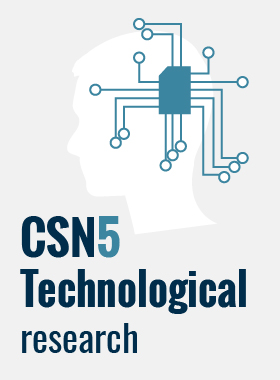- COMMISSIONI SCIENTIFICHE // SCIENTIFIC COMMITEES
National Scientific Committee 1 (CSN1)
Particle physics
 CSN1 studies fundamental interactions of matter in experiments using particle accelerators. At present, the best theory scientists have to describe our knowledge of subnuclear physics is the Standard Model. The aim of current research is to gain a deeper understanding of certain aspects, such as what generates the mass of these particles. In that context, discovering and determining the characteristics of the Higgs boson would represent a great leap forward. Scientists are hopeful that ongoing experiments will also enable them to discover new phenomena and fill some of the gaps in the Standard Model. One such example would be the discovery of supersymmetric particles, some of which are candidates for the constituents of dark matter (we know this pervades the universe, but have so far been unable to detect or describe its nature). Other examples would be the discovery of new signals that explain the asymmetry between matter and antimatter in our universe, or proof of the existence of further space-time dimensions.
CSN1 studies fundamental interactions of matter in experiments using particle accelerators. At present, the best theory scientists have to describe our knowledge of subnuclear physics is the Standard Model. The aim of current research is to gain a deeper understanding of certain aspects, such as what generates the mass of these particles. In that context, discovering and determining the characteristics of the Higgs boson would represent a great leap forward. Scientists are hopeful that ongoing experiments will also enable them to discover new phenomena and fill some of the gaps in the Standard Model. One such example would be the discovery of supersymmetric particles, some of which are candidates for the constituents of dark matter (we know this pervades the universe, but have so far been unable to detect or describe its nature). Other examples would be the discovery of new signals that explain the asymmetry between matter and antimatter in our universe, or proof of the existence of further space-time dimensions.
go to the website of the National Scientific Committee ![]()




 CSN2 coordinates research in the field of astroparticle physics. Its main purpose is to test the idea that all the fundamental interactions between the constituents of matter are unified in one fundamental force (the Grand Unified theory) and conduct research into new types of components of matter and energy (dark matter, dark energy). Since the only direct way of testing these theories would be to create much higher energy levels in a laboratory than the levels achievable using particle accelerators, they are tested indirectly using the universe as a natural accelerator. Astroparticle physics experiments are performed to study cosmic background radiation, cosmic rays, neutrinos, gravitational waves, very-high-energy gamma rays, other rare particles that could provide important clues to explain the matter-antimatter asymmetry in the universe, and particles that are thought to constitute the dark matter. The study of gravity and particularly of the gravitational waves predicted by Einstein, the existence of which has never directly been observed, represents one of the most fascinating challenges for scientists today.
CSN2 coordinates research in the field of astroparticle physics. Its main purpose is to test the idea that all the fundamental interactions between the constituents of matter are unified in one fundamental force (the Grand Unified theory) and conduct research into new types of components of matter and energy (dark matter, dark energy). Since the only direct way of testing these theories would be to create much higher energy levels in a laboratory than the levels achievable using particle accelerators, they are tested indirectly using the universe as a natural accelerator. Astroparticle physics experiments are performed to study cosmic background radiation, cosmic rays, neutrinos, gravitational waves, very-high-energy gamma rays, other rare particles that could provide important clues to explain the matter-antimatter asymmetry in the universe, and particles that are thought to constitute the dark matter. The study of gravity and particularly of the gravitational waves predicted by Einstein, the existence of which has never directly been observed, represents one of the most fascinating challenges for scientists today. CSN3 coordinates research into the structure and dynamics of nuclear matter. Italian nuclear physicists are contributing to the development of experimental techniques to study nuclei under extreme conditions. Experiments using particle accelerators enable scientists to study the mechanisms that control the development of stars in each stage of their life and to create in the laboratory the extreme conditions of density and temperature that resulted in a quark-gluon plasma, the state of the matter that probably existed in the universe for the first ten millionths of a second in the aftermath of the Big Bang. According to the fundamental theory of strong interaction (quantum chromodynamics), in this primordial phase the elementary particles of matter are distinct from one another, the nucleus of the atom does not exist and there are no protons or neutrons. The Committee is also concerned with the development of new applications, for instance, in the field of oncological hadron therapy.
CSN3 coordinates research into the structure and dynamics of nuclear matter. Italian nuclear physicists are contributing to the development of experimental techniques to study nuclei under extreme conditions. Experiments using particle accelerators enable scientists to study the mechanisms that control the development of stars in each stage of their life and to create in the laboratory the extreme conditions of density and temperature that resulted in a quark-gluon plasma, the state of the matter that probably existed in the universe for the first ten millionths of a second in the aftermath of the Big Bang. According to the fundamental theory of strong interaction (quantum chromodynamics), in this primordial phase the elementary particles of matter are distinct from one another, the nucleus of the atom does not exist and there are no protons or neutrons. The Committee is also concerned with the development of new applications, for instance, in the field of oncological hadron therapy.


